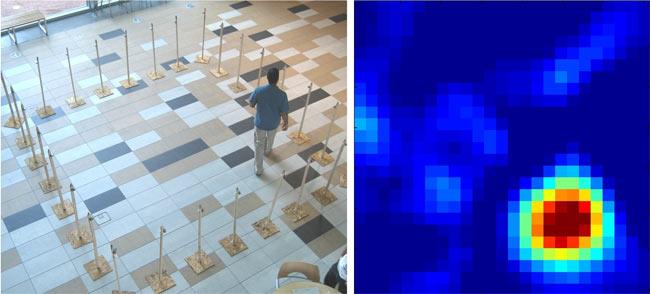Clever New Device Sees Through Walls

A new contraption that essentially sees through walls using radio receivers to track moving objects could one day help police and others nab intruders and rescue hostages or fire victims.
Joey Wilson and Neal Patwari of the University of Utah used so-called radio tomographic imaging (RTI), which can detect and track moving people or other objects in an area surrounded by inexpensive radio transceivers that send and receive signals, they announced today.
To test out the technique, the researchers placed a wireless network of 28 radio transceivers around a square-shaped portion of an atrium and a similar part of the lawn. The transceivers were placed on 4-foot-tall (1.2 m) stands made of plastic pipe so they would make measurements at a person's torso level.
As a person walked around each area, measurements showed the radio signal strengths between all of the transceivers. The resulting processed data displayed a blob-like image of the moving target on a computer screen.
A similar, yet improved method allowed the researchers to effectively see through walls. In this experiment, a network of 34 transceivers helped to track moving people behind a brick wall. This study is detailed on arXiv.org, an online archive for preprints of scientific papers. The research is awaiting publication in the journal IEEE Transactions on Mobile Computing.
Here's how the signals get converted into blob-like images:
Unlike radar, which measures radio signals that have bounced off an object, radio tomographic imaging measures "shadows" in radio waves. These shadows are essentially weaker signals created when the radio waves pass through a person or other object.
Get the world’s most fascinating discoveries delivered straight to your inbox.
Wilson and Patwari collected radio signal strength measurements in all their experiments, first when the study area was empty and then when a person walked through it. From that data, the duo developed math formulas and used them in a computer program to convert weaker signals — which occur when someone walks through the radio signals and creates so-called shadows — into a bird's-eye-view image of that person walking.
The team says such signals can travel through obstructions, such as walls, trees and smoke, and of course it works in the dark.
Although the system still needs improvements, Patwari said, "the plan is that when there is a hostage situation, for example, or some kind of event that makes it dangerous for police or firefighters to enter a building, then instead of entering the building first, they would throw dozens of these radios around the building and immediately they would be able to see a computer image showing where people are moving inside the building."
Patwari added, "They are reusable and you can pick them up afterwards."
This isn't the first device with Superman-like visual prowess.
A wireless radar technology called LifeReader, which has garnered given a first phase contract worth $850,000 by the U.S. Army, can accurately detect and monitor heart and respiration activity of multiple subjects wirelessly, with no contact to the subjects. The goal is to develop military applications for the device that can see through walls to find people inside.
An X-ray imaging technique recently revealed colorful details of a painting hidden beneath another painting by famed American artist N.C. Wyeth. Essentially, an instrument shot intense X-ray beams at the painting, which were emitted by different chemical elements in the paint pigments and collected by a microscope instrument.
A device that takes information gathered by a small digital camera in a pair of glasses and sends it to a "lollipop" electrode that sits on a person's tongue could some day help the blind to see.
- 10 Profound Innovations Ahead
- Great Inventions: Quiz Yourself
- Images: Micromachines



